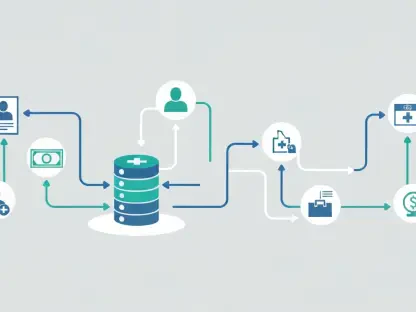Artificial intelligence (AI) has become a pivotal force in transforming software engineering productivity within the banking industry. By integrating AI into the software development cycle, banks are streamlining various processes, enhancing performance, and ushering in a new era of operational efficiency. This technological evolution is profoundly impacting the way banks manage software engineering, presenting opportunities for modernization and competitive advantage.
The Productivity Surge through AI
Boosting Coding Efficiency
At the heart of AI’s transformative effect is the enhancement of coding efficiency through large language models. These models have been instrumental in boosting programmer productivity, with reports indicating improvements ranging from 30% to 55%. In the banking sector, institutions like Citizens Bank have experienced noteworthy productivity gains by harnessing AI’s capacity to automate requirement analysis. This automation enables a rapid translation of client or business needs into functional software, effectively bridging the gap between conceptual requirements and executable code. By capitalizing on AI’s capabilities, banks are poised to generate high-quality code more swiftly, reducing development time and resource expenditure significantly.
The integration of generative AI into banking software development is leading to substantial improvements in efficiency and effectiveness. AI models can analyze hidden requests and compile comprehensive problem statements, expediting the process of building responsive software solutions. This approach not only minimizes the labor associated with initial coding efforts but also ensures that developers can focus on refining advanced features and functionalities. As these coding technologies advance, the banking industry stands to benefit from accelerated cycles of development and innovation, further enhancing their ability to meet ever-evolving client demands with precision and agility.
Innovations in Design and Testing
AI is revolutionizing the design and testing phases, enhancing the agility and precision of software engineering within the banking sector. By employing natural language processing models, system engineers gain access to initial design options that include trade-offs, facilitating informed decision-making during software development. This streamlined process enhances collaboration, enabling teams to identify effective design solutions that cater to specific project requirements. With AI suggesting viable design pathways, the efficiency and scope of software projects are broadened, allowing for the creation of more sophisticated systems.
AI-powered testing tools such as Applitools, Functionize, and Testim are critical advancements that automate test case generation and execution. These solutions learn from previous testing outcomes, continuously improving future quality by adapting to evolving project specifications. By automating testing processes, banks can significantly reduce the time required for quality assurance, enhancing the reliability and performance of their software. This emphasis on automation minimizes human error and ensures consistency, resulting in robust systems that adhere to the highest standards. As banks continue to adopt these testing innovations, productivity in software engineering is expected to rise, offering a competitive edge in terms of operational efficiency.
Overcoming Development Challenges
Addressing Inefficiencies
Despite significant investments in software development, banking institutions frequently encounter inefficiencies and scalability challenges. These issues, characterized by high maintenance costs, integration difficulties, and slower runtimes, have long plagued the industry’s development practices. AI offers a promising avenue for addressing these inefficiencies, particularly through the modernization of outdated systems. By leveraging models like IBM’s watsonx Code Assistant, banks can rewrite mainframe codes from legacy languages, such as COBOL, into modern languages like Java, unlocking newfound flexibility and usability.
Banks have recognized the value in transitioning away from cumbersome legacy systems, embarking on modernization efforts that facilitate smoother operations and reduce costs. This transition is crucial as financial institutions strive to provide seamless services in an increasingly competitive landscape. AI-driven modernization empowers banks to consolidate disparate systems, enhance functionality, and optimize processes, thus overcoming traditional barriers and setting the stage for progressive development strategies. With AI’s assistance, banking software engineering is poised to evolve, nurturing innovation and sustainability in development practices.
Supporting Modernization Efforts
Generative AI coding assistants play an integral role in advancing modernization initiatives within major banks. Institutions like Citigroup are deploying these tools to support their extensive pool of developers, underscoring their commitment to efficient coding practices and the shift to modern languages. Low code and no code solutions are central to this evolution, simplifying development processes while enabling rapid prototyping and deployment. By adopting AI-driven coding assistants, banks can reduce development cycles, empower developers, and streamline software engineering workflows.
In addition to accelerating development timelines, these initiatives contribute to the scalability and adaptability of banking systems. As banks harness AI to revolutionize their software engineering practices, they position themselves to respond swiftly to industry trends and client demands. Generative AI tools encourage innovation by offering developers the flexibility to explore new coding paradigms and experiment with novel functionalities. These advancements not only bolster productivity but also enhance the resilience and competitiveness of banking institutions. Through diligent integration of AI in modernization efforts, banks can unlock significant value and gain a strategic edge in the financial sector.
Strategic AI Integration
Targeting Strategic Initiatives
For banks to maximize AI’s potential, strategic deployment targeting persistent inefficiencies is essential. Identifying areas where AI tools can exert the most meaningful impact allows banks to direct resources effectively and capitalize on technological strengths. Strategic integration involves carefully selecting processes that benefit from AI automation and optimization, such as data analysis, coding efficiency, and testing. This focused approach ensures that banks achieve tangible productivity gains, enhancing project outcomes and fostering technological growth.
Proactive communication is a crucial component in fostering a supportive environment for software engineers adapting to AI integration. Banks must address job shifts, upskilling requirements, and new roles associated with AI-driven changes, providing clear guidance and support mechanisms. By implementing robust communication strategies, banks can cultivate a collaborative atmosphere where developers engage with AI resources confidently and constructively. This harmony between technological advancements and human capital ensures seamless transitions and maximizes innovation potential within banking software engineering.
Governance and Vendor Collaboration
The banking industry is witnessing a significant transformation in software engineering productivity due to the rise of artificial intelligence (AI). By incorporating AI into the software development lifecycle, banks are able to optimize various procedures, increase performance levels, and bring about a fundamental shift in operational efficiency. This technological advancement is not just reshaping how banks handle software engineering but also creating avenues for modernization and providing a competitive edge. AI tools facilitate automation in coding, testing, and deployment, substantially reducing human error and speeding up processes. Moreover, AI-driven analytics are enabling banks to predict trends, assess risks, and make data-driven decisions more accurately and quickly. The integration of AI is also enhancing the capacity for real-time data processing, which is crucial for personalized banking solutions. Thus, AI is playing a crucial role in pushing the boundaries of what’s possible in banking software engineering, making it a catalyst for innovation and competitive strategy.









